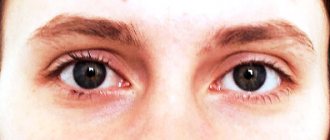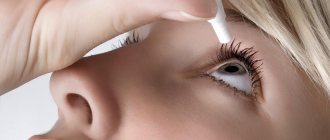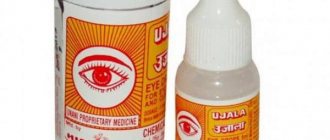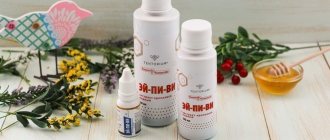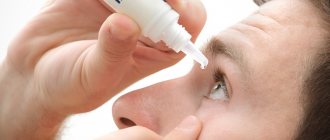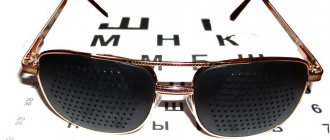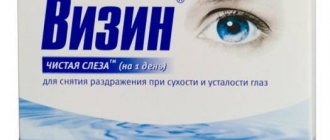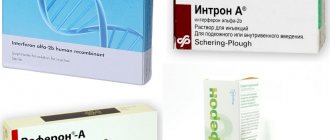Every day, human eyes are exposed to heavy loads and adverse effects of external factors. In order to eliminate inflammation, relieve fatigue and inflammation, a special drug was developed - Visin eye drops, which are fast-acting and have few contraindications.
The drug has a vasoconstrictor, anti-edematous and anti-inflammatory effect. Currently, Visin eye drops are widely used in ophthalmic practice to treat inflammation and allergic manifestations.
Visin drops are often used by patients suffering from dry eye syndrome, which develops when overworked as a result of prolonged work at the computer, when driving, when in a room with dry air, itching and burning due to allergic reactions.
The main advantages of the drug are:
- elimination of irritation in a short time;
- restoration of the tear film;
- long-term hydration of the mucous membrane;
- normalization of the condition of the conjunctiva and cornea of the eye for a long time;
- possibility of systematic application;
- a small number of contraindications and restrictions on use due to age;
- ease of use.
On the pharmaceutical market, Vizin eye drops are represented by Canadian manufacturers.
Instructions and dosage
According to Visin's instructions, eye drops are intended to provide emergency assistance to the eyes with swelling, pain and redness of the eyes. The effect of the medicine occurs within one minute after use and lasts for 6-8 hours.
The product is instilled 1-2 drops twice a day into each conjunctival cavity. The duration of use of the drug should not exceed 4 days.
Eye drops are recommended for use for minor visual impairment. If within two days from the moment of using the product there is no improvement in the condition, it is better to stop using the drops and seek advice from a specialist.
You should not self-medicate and use the drug to treat conjunctivitis of bacterial origin, in case of traumatic damage to the mucous membrane or removal of a foreign body.
Contact lenses should be removed before using eye drops. When instilling, do not touch the surface of the eye with the dropper.
Use during pregnancy
Since there is no data from clinical studies on the possible negative effects of the active substance on the fetus, the use of the drug during pregnancy and lactation is carried out strictly as prescribed by a doctor in case of emergency.
Use in childhood
The use of Visin drops is not recommended for children under two years of age. For the treatment of children under 6 years of age, drops are used as prescribed by a specialist to eliminate eye irritation. The dosage and treatment regimen should be determined by the attending physician.
Using Visine for acne
The drug has proven its effectiveness in the treatment of acne and pimples. The therapeutic effect is associated with the vasoconstrictor properties of the drug. After using eye drops, acne becomes less noticeable.
However, you should know that eye drops can only eliminate the external manifestation, but not get rid of the cause of acne. As a rule, the product is used if there is a need to hide a pimple that has appeared. The effect of the medicine in this case lasts no more than four hours.
Vizin Alergy
The drug helps to quickly relieve allergy symptoms . Its active component is levocabastine, a histamine receptor blocker. Once on the surface of the eye, it instantly binds to cellular receptors and neutralizes the irritating effect of histamine. This allows you to remove itching, watery eyes and irritation of the eyes within 5 minutes.
Visin Alergy also contains benzalkonium chloride . Therefore, the drug is incompatible with contact lenses. Every time you instill it, you need to remove the SCL.
Contraindications and side effects
According to the instructions for use of Vizin drops, it is prohibited to use if the patient is diagnosed with the following diseases:
- individual intolerance to individual components of the drug;
- angle-closure glaucoma;
- endothelial-epithelial dystrophy of the cornea;
- diseases of the heart and blood vessels;
- diabetes;
- hyperthyroidism;
- low blood pressure.
of drops for the treatment of children under two years of age is not recommended
The drug has a local effect and practically does not enter the bloodstream, so side effects develop very rarely. Typically, side effects may be due to incorrect dosage. It is usually expressed by the following symptoms:
- pain and double vision;
- hyperemia;
- headache;
- floating spots before the eyes.
In this case, use of the medicine should be stopped immediately and consult a specialist.
These manifestations are temporary, go away on their own and do not require additional treatment.
Visin drops can be addictive, so they should not be used for more than 4 days. With prolonged use of the drug, patients experience redness of the eyes, caused by severe vasoconstriction and deterioration of tissue nutrition.
interesting article about Visine drops and contact lenses.
Interview of the Chief Physician of the Sfera Laser Medicine Clinic, Professor Erika Naumovna Eskina, to the editors of the magazine “HEALTH”
Contact vision correction today is a modern, convenient and affordable way to see the world in all its colors. However, there is also a flip side to the coin - wearing contact lenses requires special care for the lenses and eyes. In order to find out how to properly care for the eyes of those who wear contact lenses, a correspondent for Health magazine
Oksana Gerasimenko talked with Doctor of Medical Sciences, Vice-Rector for Science of the State Academy of Culture named after.
Maimonides, chief physician of the Sfera laser medicine clinic, Professor Erika Naumovna Eskina
, who kindly agreed to give an interview.
Good afternoon, Erika Naumovna!
It is no secret that people who constantly wear contact lenses often resort to drops such as “artificial tears” to eliminate dryness and redness of the eyes. What exactly are the harmful effects of such drops (“Blue Drops”, “Vizine”, etc.). Is it only vasoconstrictor? Hello. You see, Artificial Tear drops and Visine drops are different drugs. “Artificial tears” are intended only to moisturize the surface of the eye, “Blue drops”, “Vizin” and their analogues are intended to achieve a cosmetic effect and remove redness of the eyes. They reduce swelling and hyperemia of the conjunctiva, burning sensation, irritation, itching, soreness of the mucous membrane of the eyes, and lacrimation. The effect develops a few minutes after instillation and lasts 4-8 hours. They contain the vasoconstrictor component tetrizoline hydrochloride or an analogue, which belongs to the group of adrenergic agonists and can have a systemic effect. The effect of adrenomimetics is manifested by a narrowing of most blood vessels, increased myocardial contractions, increased heart rate, increased automaticity and improved conductivity in the heart muscle, dilation of the bronchi and pupils. In case of overdose, tremor, agitation, insomnia, pupil dilation, nausea, cyanosis, fever, convulsions, tachycardia, arrhythmia, cardiac arrest, arterial hypertension, pulmonary edema, impaired respiratory function and mental activity may develop. When using these drops, direct contact with soft contact lenses should be avoided due to possible disruption of their transparency. If irritation and redness persist or increase within 48 hours, as well as if intense pain in the eyes, headaches, loss of vision, sudden appearance of “floating” spots in front of the eyes, pain when exposed to light or double vision occurs, stop instillation and contact doctor. When driving a car or operating machinery, you should be aware of the possibility of blurred vision. Drops should be used with caution by patients suffering from coronary artery disease, arterial hypertension (severe forms), receiving MAO inhibitors or other drugs that increase blood pressure, lactating women and during pregnancy.
Tell me, what causes this effect? What is in the drops that makes them harmful to the eyes?
As I said earlier, these drops contain adrenergic agonists, which cause the above reactions in the body. In addition, the trouble is that not everyone reads the instructions for the drugs that they are used to buying or someone they know advised them to use.
What makes the eyes moisturize when using Visine?
Eye hydration, as becomes clear from the description of the drug, does not occur, and whitening of proteins occurs due to vasoconstriction. The dangers of long-term use of these drops can be judged if, by analogy, we recall the cases of chronic atrophic rhinitis, addiction, and dependence with long-term use of drops such as “Naphthyzin” and “Galazolin”. These drugs are “one of a kind”, and in the case of the “Blue Drops” that I was able to find, they are not a drug at all. That is, they do not undergo strict composition control, and the name of the dye that gives these drops a blue tint is unknown. The remaining components that provide the cosmetic effect of these drops have a vasoconstrictor effect similar to adrenomimetics.
If the drops are harmful and should be used under the supervision of a doctor, why are they on the market? Should they only be prescribed by a doctor? And tell me that it’s a one-time use?
As a medicine, the drops are not harmful, and they can and should be used for certain diseases. It’s just that a doctor should prescribe medications, and in the mentality of our patients, the best doctor is our friends and acquaintances, and more often than not, even ourselves. We remember what once helped us and begin to apply it and advise everyone. So your question relates rather to the regulation of the pharmaceutical market in our country. Suffice it to say that in Europe such a situation simply could not have developed, since all medications are dispensed there only with a doctor’s prescription.
How often can such drops be used or not at all? Could there be a toxic effect with long-term use?
I repeat that only the attending physician can draw a conclusion about the need, dosage and duration of use.
How to moisturize the eyes of those who wear lenses?
There are special moisturizing drops that can be placed directly on the lenses. As a rule, they are sold in contact correction offices and optics. These drops contain lubricating and moisturizing components that form a water-soluble polymer system, as well as preservatives to ensure the durability and sterility of the drug. Oil-based drops are available for sale. Are they safer? And how much safer are they for the eyes?
The oil base of the drops is used to improve the bioavailability of the active substance. In any case, this is a medicine and should not be used without a doctor’s prescription.
Erika Naumovna, what can you say about monthly lenses, which supposedly can be worn without taking them off for a month? Optometrists say that modern lenses are made of special materials that “breathe” and allow oxygen to pass through. Is it so? And what about from a hygiene point of view, do microbes and bacteria accumulate behind the lens?
As a rule, such lenses undergo lengthy testing before they are approved for use. However, there are no lenses that would not disrupt the nutrition of the cornea or change the circulation of tear fluid. Conclusion: unless absolutely necessary, you should not wear even the best contact lenses around the clock.
It turns out that Visine and Blue Drop have only a symptomatic effect?
For some diseases and therapeutic. You just need to carefully read the instructions for the drug. Are there alternative ways to avoid dry eyes? For example, use folk remedies (washing the eyes with infusion of chamomile and calendula, tea)? Include vegetable oils in the menu? I also read a recommendation to put sea buckthorn oil in your eyes.
The fact is that moisturizing drops created by the pharmaceutical industry are, in any case, more sterile, stable and easy to use than folk remedies. Commercially available sea buckthorn oil is not intended for use as eye drops, meaning it can cause irritation, burning, and even burns. So I don’t recommend taking risks.
Thank you very much, Erika Naumovna, for such an informative interview!
Overdose
If you strictly follow your doctor's recommendations, there is virtually no risk of overdose.
Accidental ingestion of the drug may cause nausea, vomiting, chills, dilated pupils, impaired cardiac and respiratory activity, rapid heartbeat, convulsions, increased blood pressure, and pulmonary edema.
If the drug is swallowed, you should immediately rinse the stomach, induce vomiting and seek qualified medical help. To eliminate symptoms, the use of adsorbents, oxygen inhalations, antipyretics and anticonvulsants is recommended.
Visin drops for acne
In addition to eliminating the symptoms of eye diseases, the vasoconstrictor effect of the drug can be used when acne appears on the skin. It relieves redness and inflammation, making the inflamed area less noticeable.
Visine can only be used for single pimples; it is not used to treat acne or extensive skin damage by inflammatory elements.
The effect lasts up to 4 hours. Drops are used up to 3 times during the day. Before the procedure, cleanse the facial skin. Apply 3-4 drops to a cotton pad or cotton wool and apply to the inflamed element for 5-7 minutes.
Read more Eye drops Oftan Katahrom: instructions for use
Reviews
Frequent eyelash extensions can cause irritation and redness of the eyes. On the doctor’s recommendation, I started using Visin eye drops. Drops quickly eliminate unpleasant symptoms. I recently started using Visin Pure Tear, which helps eliminate tension and red eye syndrome after working at the computer for a long time.
Lily
I often use Visin drops, which help get rid of dry eyes and swelling. The condition improves significantly within a few seconds. This product is always in my home medicine cabinet.
Svetlana
I use Visine to relieve eye strain after working at night. Drops quickly eliminate pain and pain in the eyes. The drug is really effective, but it cannot be used for a long time.
Vladimir
Originally posted 2018-01-29 07:09:31.
Instructions for use of Visin eye drops
To get a positive effect and prevent the development of overdose symptoms and mucosal injuries, you must follow the instructions.
Read more Atropine - instructions for using eye drops
Dosage
The product is used only locally. Instill 1 drop under the conjunctiva into one or both eyes 2-3 times a day for adults and children over 2 years of age. Duration of use is no more than 4 days. If prescribed by a doctor, a second course is possible after 3-4 days. If there is no positive effect within the specified period, it is necessary to consult an ophthalmologist and replace the drug with an analogue.
Rules of application
Before use, wash your hands thoroughly. If a person wears lenses, they should be removed and put back on 20-30 minutes after the procedure. To instill drops, you need to lie down or tilt your head back, pull down the lower eyelid with your index finger and insert 1 drop. In order for the drug to be evenly distributed throughout the membrane, you need to close your eyes and make circular movements with your eyeballs or blink frequently.
Reviews of the use of Visine for acne
Natalya, 23 years old, Astrakhan: against the background of a hormonal surge, sometimes 1-2 large pimples can appear, which are difficult to disguise even with good cosmetics. I learned from a friend that Visin drops save her at such moments. I decided to try it and did not regret it. Redness and swelling are removed literally before your eyes, you don’t even have to cover it up too much.
Olga, 20 years old, Tomsk: I’ve always suffered from problem skin, so I’ve tried a lot of products, and the drops really help, especially if you put the disc moistened with the drops in the freezer for 10 minutes. Ice in combination with drops gives an excellent effect, redness goes away in an instant. But if there are a lot of pimples on the skin, the drops will not help; here you need to find out the cause of the inflammation.
Composition and pharmacological properties
The main active ingredient in Visin Classic eye drops is tetrizoline hydrochloride. Auxiliary components are: boric acid, disodium edetate, sodium borate, benzalkonium chloride solution 17%, sodium chloride and purified water.
Visin Classic is an ophthalmic therapeutic agent belonging to the group of alpha-adrenergic agonists. Tetrizoline hydrochloride acts on the ocular vessels, narrowing them, due to which the swelling of the conjunctiva decreases, the formation of intraocular fluid decreases, and the pupil dilates. At its core, the composition of Visin is close to tears, but with less antibacterial effect.
The effect of the drug begins quite quickly, a couple of minutes after instillation. The effect lasts up to 8 hours. The instructions for Visin eye drops indicate that it does not penetrate into the blood and does not have a general effect on the body.
